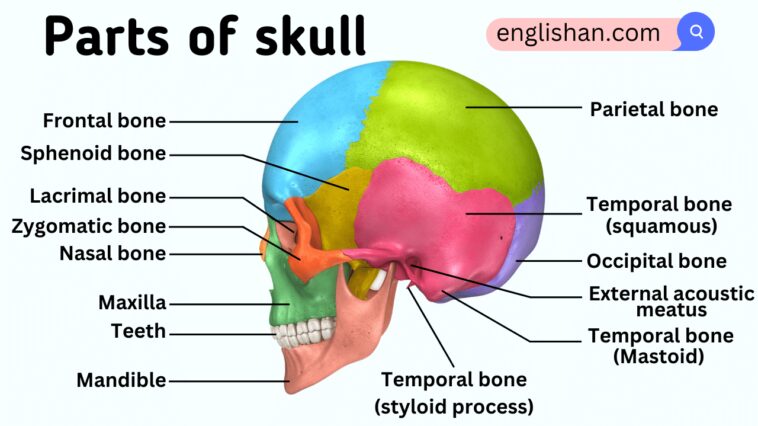The human skull, like a sturdy fortress, protects our most vital organ, the brain. Divided into key parts, the cranium forms the top and back, including the frontal bone at the forehead and the occipital bone at the base. Facial bones, like the mandible (movable jaw) and maxilla (upper jaw), shape our face and help with eating and speaking. Cheekbones (zygomatic bones) and nasal bones add character to our features. The eye sockets, made up of various bones, safeguard our eyes. Everything fits together with joints and sutures, emphasizing unity. In simpler terms, the skull is like a puzzle—each piece has its role, ensuring our head stays strong, safe, and functional. Understanding these parts unveils the awe-inspiring design that keeps us going every day.
What is a Skull?
The skull is the bony structure that makes up our head and protects our brain. It’s like a hard shell that surrounds the brain, keeping it safe. The skull also includes the face and jaw, giving our head its shape. It’s an important part of our body’s framework and helps keep everything in place.
Structure of Skull
The skull is like a superhero team protecting our head. The cranium forms a strong dome around the brain, with bones like the frontal, parietal, and occipital. The lower jaw (mandible) helps us chew, while the upper jaw (maxilla) holds our upper teeth. Cheekbones shape our face, and nasal bones form our nose. The orbits, like shields, protect our eyes. There’s also the sphenoid and ethmoid bones. Together, this superhero team keeps our head in shape and our brain and senses safe. Understanding this cool design gives us a peek into what makes us tick!
Importance of Understanding the Anatomy of the Skull
Understanding the anatomy of the skull is crucial for several reasons, ranging from medical and scientific perspectives to practical applications in various fields. Here are key reasons highlighting the importance of comprehending the skull’s anatomy:
- Medical Care: Diagnosis and Treatment
- Importance of Skull Anatomy for Healthcare Professionals
- Precision in Surgical Planning and Procedures
- Neurological Insights: Brain Protection
- The Crucial Role of Skull Structure in Brain Function
- Interpreting Neuroimaging Studies with its Knowledge
- Dental and Oral Health: Beyond the Surface
- Dental Practices and the Anatomy of the Skull
- Oral Surgeries and the Impact of Skull Structures
- Forensic Sciences: Identifying Individuals
- Facial Reconstructions and Skull Anatomy
- Estimating Age, Sex, and Ancestry through Features
- Anthropological Significance: Tracing Human Evolution
- Skull Anatomy in Anthropological Studies
- Understanding Population Diversity through Skull Measurements
- Biomechanics and Sports Safety
- Skull Anatomy’s Role in Sports Medicine
- Designing Protective Gear for Head Safety
- Aesthetic Considerations: Plastic Surgery and Facial Harmony
- Skull Anatomy in Facial Aesthetics
- Achieving Natural Results through Understanding Bone Structure
- Education and Training: Building a Strong Foundation
- The Importance of Skull Anatomy in Medical Education
- Enhancing Proficiency and Advancements in Medical Science

Parts of Skull with Their Functions
The skull is a complex structure that encases and protects the brain. It is divided into two main parts: the cranium and the mandible.
Cranium
- Frontal Bone: Forms the forehead and upper part of the eye sockets (orbits).
- Parietal Bones (2): Two large bones that form the top and sides of the skull.
- Temporal Bones (2): Located on each side of the skull, these bones house the ear structures.
- Occipital Bone: Forms the back and base of the skull, containing the foramen magnum through which the spinal cord passes.
- Sphenoid Bone: Butterfly-shaped bone at the base of the skull, forming part of the eye sockets and the floor of the skull.
- Ethmoid Bone: Located in front of the sphenoid, contributing to the eye sockets and nasal cavity.
Facial Bones
- Mandible: The lower jawbone, the only movable bone of the skull.
- Maxilla (2): Upper jawbones that form the upper jaw and part of the eye sockets.
- Zygomatic Bones (2): Cheekbones that form the sides of the eye sockets and part of the cheek.
- Nasal Bones (2): Form the bridge of the nose.
- Lacrimal Bones (2): Small bones forming part of the eye sockets.
- Palatine Bones (2): Form the posterior part of the hard palate (roof of the mouth).
- Inferior Nasal Conchae (2): Thin, scroll-like bones in the nasal cavity.
- Vomer: Forms the lower part of the nasal septum.
Hyoid Bone
- Not part of the skull but located in the neck.
- Suspended in the mid-neck region, providing support for the tongue and serving as an attachment point for some neck muscles.



